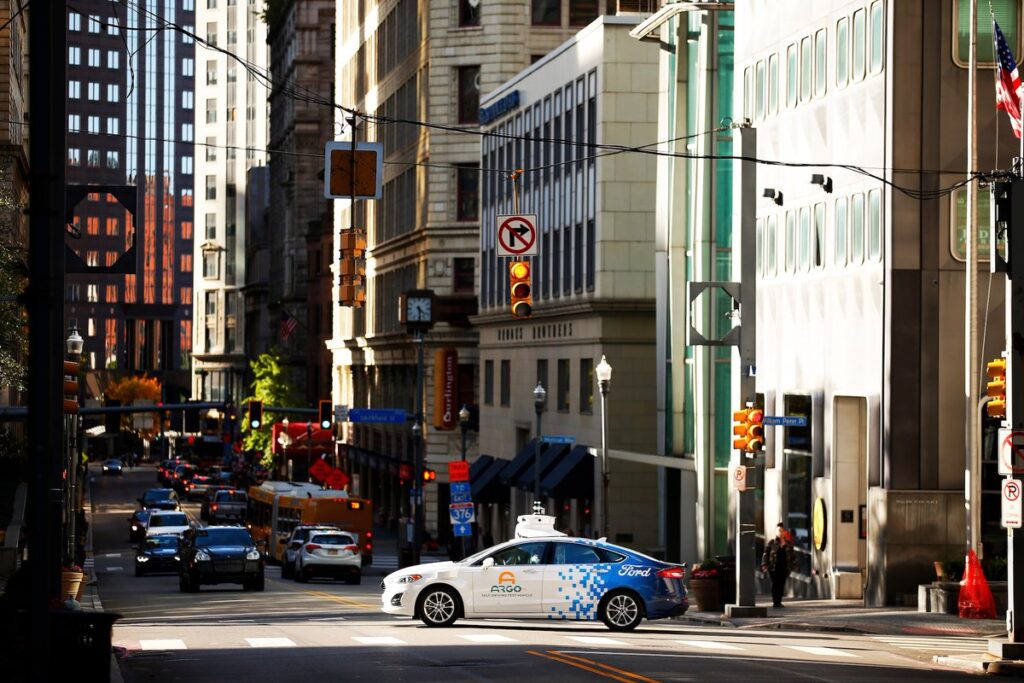A recent pilot project in the US city of Pittsburgh that combined Argo AI’s self-driving vehicles with smart infrastructure technology from Rapid Flow Technologies to see if it improved travel times has seen a 40% reduction in the time wasted sitting at red lights. The project was inspired by promising results from an earlier smart infrastructure-only trial held in the city by Pittsburgh-based Rapid Flow Technologies.
The company’s flagship AI technology, Surtrac (pronounced ‘sure-track’), is deployed at traffic lights and receives data from sensors about the number of vehicles, pedestrians, and other road users that are approaching an intersection. Surtrac then generates predictive models used to optimize traffic in real-time, aimed to move traffic through the intersection most efficiently. Rapid Flow has found that with this basic passive sensing, monitoring, and management system, Surtrac delivers human-driven vehicles a 20-25% improvement in travel times.
Impressed by the results from Surtrac trials, Argo AI sought to determine if its self-driving vehicles could improve even further on that performance.
The pilot, conducted over the course of several weeks last year, comprised 15 of Argo AI’s self-driving test vehicles. As the vehicles moved around the streets of Pittsburgh, they collected and shared data in real time about their route positions, speed, braking, and idling. Argo AI’s AVs reported this data back to Surtrac computers via a wireless-based cloud communication system that Rapid Flow calls Routecast. Rapid Flow fed all this data into its scheduling algorithms to optimize traffic-light timing and make it more likely for the test vehicles to be met by green lights.
As a result, the system achieved a 40% reduction in delay, or time wasted sitting at red lights, demonstrating that with self-driving vehicles on roadways sharing information with smart infrastructure, cities can improve traffic flow and cut congestion even further.
The pilot project also revealed tangible ways that connected intersections can help the Argo self-driving system solve for situations where a traffic light could be occluded from view. Specifically, connecting to a smart signal network could give Argo AI vehicles an added layer of detection in such rare situations as when a traffic light is blocked from the vehicle’s sensors’ view. If the sun’s glare is blinding, or a tall delivery truck or building is preventing visibility of a particular light, the self-driving vehicle could still know the state of the signal, even if it isn’t visible to its sensors.
Overall, Argo AI says the pilot project demonstrated that vehicle-to-everything (V2X) technology could bring great value to cities and their residents.
“Nobody likes to be stuck in traffic, or idling at a stoplight watching the time tick by, and the predictive powers of a self-driving vehicle-connected smart infrastructure system promise to free up precious minutes for every driver using the road,” said Dr. Brett Browning, executive VP of product development and CTO, Argo AI, in a blog post about the trial, on the company’s website. “Extrapolate that for an entire city full of commuters – that’s a lot of time not spent in traffic. And those improvements apply for all commuters and residents of cities, whether they use self-driving vehicles or not.”
Argo says its self-driving vehicles do not require V2X capabilities for safe operation, and the company is developing its self-driving system to function without it, but is interested in exploring how AVs can help V2X technology improve traffic flow even further, and conversely, whether its own mapping and predictive capabilities can be enhanced by integration with smart infrastructure.
“One thing is certain: we would like to see V2X in the future,” concluded Browning. “Our automaker partners Ford and Volkswagen are big supporters of smart infrastructure, so we look forward to collaborating with partners on solutions that address how to take even more advantage of the new technology down the road.”


